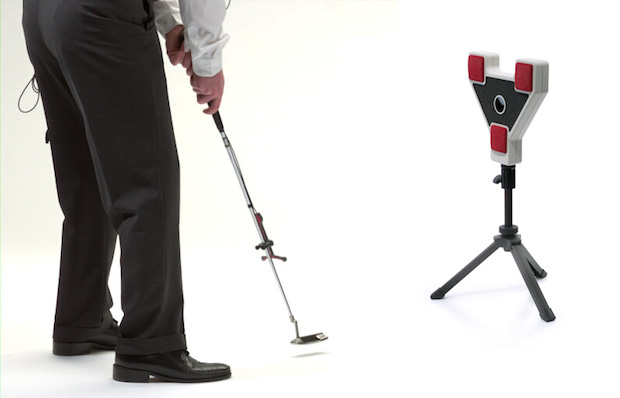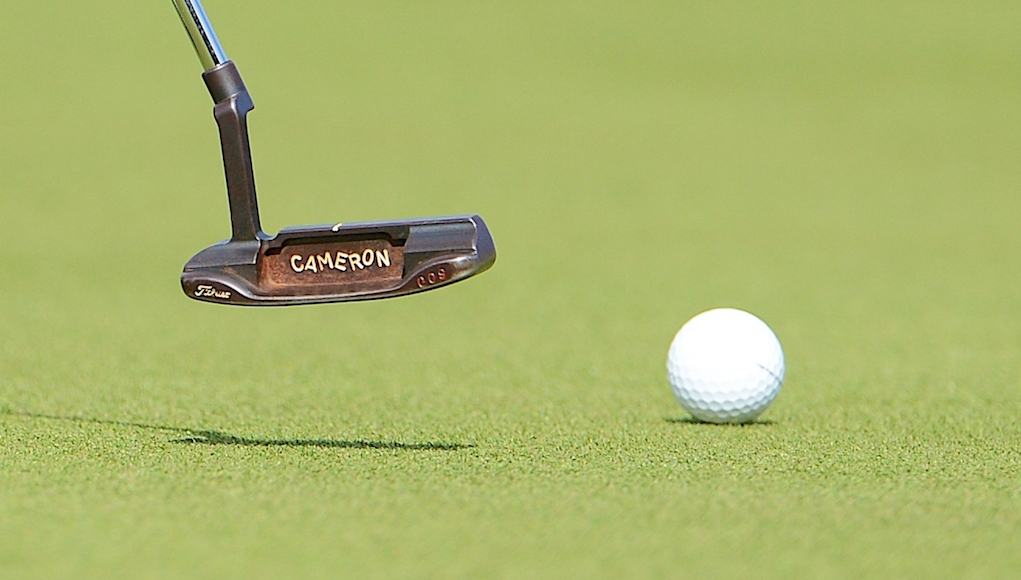Instruction
Charting the putting stroke differences in different handicap golfers

One of the most troubling parts of putting for many golfers has been the relationship between line and speed. Most golfers know that the proper line is determined by the speed at which a putt is hit, but how do golfers know how hard to hit the ball? How can one really understand “what to feel” without doing it correctly first? Isn’t there a more scientific way to audit feel and help people to become better at hitting the ball the same distance when they want to over and over?
In my putting academy I use several tools. For this article, I will use Advanced Motion Measurement’s 3D Motion Analysis System and the SAM Puttlab created by Science & Motion Sports to help you understand “feel.” These two high-tech systems will be used to correlate the data contained below.
Using the SAM, I will correlate the “time signatures” and “stroke lengths” of 10 putts in succession charting the backswing speed, forward swing speed, time to impact and overall putter-head acceleration for players of varying levels.
Hypothesis
The more rudimentary a player’s proficiency level, the less consistency we should see in the player’s length of stroke back and through as well as their control of the putter head’s speed and acceleration on the way back and through.
We will focus on a few things on this page in regards to the “Putter Path:”
- The overall length and consistency of the backstroke (shown by the dotted line).
- The overall length and consistency of the forward stroke (shown by the solid line).
- The amount of “loops” or “loose motions” going back and/or through.
- The amount of “curly-Q’s” at the end of the forward swing.
The top left time graph pertains to putter head speed on the way back. It shows just how fast the putter is moving in milliseconds. The tour average is around 650 ms.
The top right time graph shows the speed of the putter into the forward swing, through impact, and into the finish. The tour average is around 300 ms.
The bottom left time graph is the acceleration of the putter from address to the top of the backstroke. A flat line shows that acceleration is constant, thus, the speed of the putter head at this point is neither accelerating nor decelerating.
The bottom right time graph shows the transitional acceleration of the putter into the forward swing and on to the finish. The steeper the line moves up the more putter acceleration a golfer has and the faster the putter is moving in milliseconds. If the line descends then the putter acceleration is slowing and its speed is diminishing.
One note regarding “stroke length” and “timing signatures.” It is very easy to repeat a stroke that is consistent in length, acceleration and timing if and only if a golfer’s impact alignments are sound and solid. In this study we understand that the more basic the player’s skills, the greater the chance there is of an impact alignment breakdown. That will make the post-impact putter path data look very inconsistent. This action will be shown by the excessive “curly-Q’s” at the end of the forward stroke graph. It is my thought within this study to test my hypothesis above, showing that stroke length and timing signatures should correlate and do so as players become more proficient.
The 3D Analysis of the Professional used in the “correct” putting sample graphs above shows that at impact the forward wrist and rear wrists are in solid alignments as the shaft is leaning 0.1 of a degree forward. This is the most consistent impact position that a golfer can have. Whenever the forward wrist “breaks down” and the club shaft leans back through impact a golfer has added loft to the putter face, which makes “feel” almost impossible to have when a golfer needs it.
The Tour Professional Stroke Length Graph
As stated earlier, each professional player was asked to hit the same 15-foot putt 10 times without being able to see to the ball’s finish position while the data was taken. As you could imagine, the backswing length and forward swing length are symmetrical indicating consistency within the length of stroke on the same flat 15-foot putt.
The Tour Professional Time Signature Graph
The timing signatures of the above putts show a very consistent motion in regards to speed and acceleration. As you can see, the timing signature on all of the lines on the four graphs are not jagged during the backswing and/or forward swing. This shows consistency within this player’s putter head speed and putter head acceleration back and through.
The Scratch Player Stroke Length Graph
In viewing the overall length of the stroke from the above graph, you will see that the backswing length of the stroke is very consistent, however, there are some issues in regards to the follow-through length of the stroke itself. Whenever you see disruptions in the finish length of the stroke, this is an indication of improper backswing length, speed and acceleration. The overall backswing shape looks reasonable, but in viewing this on a closer scale you will see that the direction of the backswing (shown by the dotted line) and the subsequent “loop” of the transition shows some inconsistencies, thus the overall lack of general consistency in the follow-through length, shape and direction.
The Scratch Player Time Signature Graph
Above we stated that the backswing length and shape was reasonable (this player is a scratch player), but it is not at all close to the forward and backswing graphs of the tour player. As noted, the real issues were shown in the follow-through stroke lengths and this was mainly due to poor consistency of the backswing length and acceleration. In fact, if you look at the backswing acceleration graph on the bottom right you will see that the lines are “tight” but do not appear as “one” as shown by the tour professional. Subsequently, there was a lack of overall consistency in forward swing length. These issues and player compensations are shown very dramatically in the forward swing speed and acceleration graphs above. This scratch player fights his backswing acceleration consistency and the forward swing speed and acceleration graphs are greatly compromised as a result
10-Handicap Stroke Length Graph
In a 10-handicap player, the inconsistencies within the backstroke length, follow-through direction and length start to become obvious. This is easily shown through examining the backswing lengths on the right of the graph above as well as the symmetries and overall direction of the follow-through lines to the left of the dots. The “curly-Q’s” show the excessive hand action of this player trying to make up for the improper motion of the stroke he perceived internally as he putted and saw the previous ball’s reactions.
10-Handicap Time Signature Graph
Now that we have seen that the normal 10-handicap player has some type of swing length issues, it is interesting to note that, yes, the timing graphs become more inconsistent as well but do not indicate the brutal inconsistencies we saw above in stroke length. This helps us to understand that one’s stroke can vary in length and timing, but if there was one part to this equation that overcomes another it would be the fact that golfers can still putt to a relatively successful level if their timing signatures are not grossly out of sync. There is not much difference between a 10-handicap and a scratch player on the putting green except a few three-putts and a few missed up and downs with some being contributed to leaving the ball on the incorrect side of the hole.
20-Handicap Stroke Length Graph
As we examine the difference between the 10- and 20-handicap player, you will see a huge difference between the levels of these types of putters. As seen in the above graph, this player has trouble controlling the length of his stroke back and through, providing general inconsistency on putts of any distance or shape. Remember that this mid-handicap player was asked to hit the SAME length putt over and over (15 feet) and this lack of consistently shows that his player cannot control the overall feel and putting stroke length from stroke to stroke. This is where all the three putts come to light. And as you can tell, this would make it very hard for this player to develop a consistent “feel” on the greens because nothing is constant from putt to putt and stroke to stroke.
20-Handicap Time Signature Graph
Examining the four graphs above helps us to see that each of these strokes had a very different “timing signature” and logically, if golfers cannot move the putter back and through the same speed on the same length putt they are going to have problems with pace.
Something interesting to see: The backswing timing graphs do not show that big of difference between the 10- and 20-handicap player, but the swing length and forward swing speed and acceleration graphs are very, very inconsistent. This is the biggest difference between these two players. As stated earlier, golfers MUST control their swing length and forward swing speed and acceleration.
Did this player have trouble with his speed because his swing length was off or did he have trouble with his swing length because his speed was off? I believe that it can happen either way. If you watch players who take the putter back super slow, they will adjust and move through much faster when they have allowed the backswing tempo to become too slow. The opposite argument can be made, however, when this player takes the club back too long or too short. His subconscious takes over and he adjusts his swing length through the ball to accommodate. When this reaction occurs, his timing signatures become grossly inconsistent.
36-Handicap Stroke Length Graph
It is not very surprising to see that a 36 handicapper has little “feel” in backswing shape, direction, or length, thus he will have no control of the putter head in general.
36-Handicap Time Signature Graph
You will also find that the timing graphs are all over the board as well. This player has no idea what to “feel,” thus he will have a hard time with any outcome driven type of practice. The key for this player would be to help understand how to FEEL the proper length stroke for putts of differing lengths and then to associate the proper speed and acceleration required to make this happen with the proper putting stroke length.
The Beginner Stroke Length Graph
The Beginner Time Signature Graph
Just for fun, we also tested several players who have never played golf and this is what we saw as a sample graph for length and timing. There is no consistency in stroke length, stroke direction, backswing/forward swing consistency in speed and acceleration. These strokes, however, are “natural” and have no conscious thought in them unlike the 36 handicapper above. The 36-handicap player has more evidence of curly-Q’s due to his hands taking over in order to try and force the ball where he wanted it to go. But the total beginner has no evidence of controlling the ball with his hands. He simply moves the putter and just see where it goes. Thus, the point must be made that the only real difference between a total neophyte and 36 handicappers is that the more experienced player has learned to better manipulate his hands, but he has NOT improved his stroke or timing in general.
The Mechanical Conclusion: The SAM proves that in order to have “feel and control” on the greens, golfers must do several things at once in order to reproduce the same stroke:
- They must control the overall length of their backstroke and follow-through on putts with the same general length.
They must control not only the overall speed of their overall stroke, but its acceleration as well; thus, all the lines on each graphs will almost appear as “one.”
If they are “swing” putters like Ben Crenshaw, golfers must accelerate into the impact zone and maintain a constant velocity through impact in order to control the ball’s reaction (shown below). This is shown on the bottom right graph by the “table-top” looking acceleration curve. Impact occurs at the point where the “table-top” falls off on the right side. This is the acceleration signature of a player who plays on fast greens.
As a “hit” putter like Nick Price, golfers must accelerate off the beginning of the backstroke and into to the ball with a “popping” type of action (shown below). This is shown on the bottom right graph as acceleration begins, table-tops just before impact and then accelerates once again into the ball (shown by the steep peak) and then drops off rapidly. The second acceleration is the “pop” through impact seen by Price and is usually a mark of someone who has grown up on slower greens.
During the forward swing and into and through impact, a golfers wrists should remain as solid as possible allowing the club shaft to return to the golf ball in a position that will allow it to propel the ball as consistently as possible.
Read More Tom Stickney II : What Flightscope and Trackman can tell you (and me)
Instruction
The Wedge Guy: Beating the yips into submission

There may be no more painful affliction in golf than the “yips” – those uncontrollable and maddening little nervous twitches that prevent you from making a decent stroke on short putts. If you’ve never had them, consider yourself very fortunate (or possibly just very young). But I can assure you that when your most treacherous and feared golf shot is not the 195 yard approach over water with a quartering headwind…not the extra tight fairway with water left and sand right…not the soft bunker shot to a downhill pin with water on the other side…No, when your most feared shot is the remaining 2- 4-foot putt after hitting a great approach, recovery or lag putt, it makes the game almost painful.
And I’ve been fighting the yips (again) for a while now. It’s a recurring nightmare that has haunted me most of my adult life. I even had the yips when I was in my 20s, but I’ve beat them into submission off and on most of my adult life. But just recently, that nasty virus came to life once again. My lag putting has been very good, but when I get over one of those “you should make this” length putts, the entire nervous system seems to go haywire. I make great practice strokes, and then the most pitiful short-stroke or jab at the ball you can imagine. Sheesh.
But I’m a traditionalist, and do not look toward the long putter, belly putter, cross-hand, claw or other variation as the solution. My approach is to beat those damn yips into submission some other way. Here’s what I’m doing that is working pretty well, and I offer it to all of you who might have a similar affliction on the greens.
When you are over a short putt, forget the practice strokes…you want your natural eye-hand coordination to be unhindered by mechanics. Address your putt and take a good look at the hole, and back to the putter to ensure good alignment. Lighten your right hand grip on the putter and make sure that only the fingertips are in contact with the grip, to prevent you from getting to tight.
Then, take a long, long look at the hole to fill your entire mind and senses with the target. When you bring your head/eyes back to the ball, try to make a smooth, immediate move right into your backstroke — not even a second pause — and then let your hands and putter track right back together right back to where you were looking — the HOLE! Seeing the putter make contact with the ball, preferably even the forward edge of the ball – the side near the hole.
For me, this is working, but I am asking all of you to chime in with your own “home remedies” for the most aggravating and senseless of all golf maladies. It never hurts to have more to fall back on!
Instruction
Looking for a good golf instructor? Use this checklist

Over the last couple of decades, golf has become much more science-based. We measure swing speed, smash factor, angle of attack, strokes gained, and many other metrics that can really help golfers improve. But I often wonder if the advancement of golf’s “hard” sciences comes at the expense of the “soft” sciences.
Take, for example, golf instruction. Good golf instruction requires understanding swing mechanics and ball flight. But let’s take that as a given for PGA instructors. The other factors that make an instructor effective can be evaluated by social science, rather than launch monitors.
If you are a recreational golfer looking for a golf instructor, here are my top three points to consider.
1. Cultural mindset
What is “cultural mindset? To social scientists, it means whether a culture of genius or a culture of learning exists. In a golf instruction context, that may mean whether the teacher communicates a message that golf ability is something innate (you either have it or you don’t), or whether golf ability is something that can be learned. You want the latter!
It may sound obvious to suggest that you find a golf instructor who thinks you can improve, but my research suggests that it isn’t a given. In a large sample study of golf instructors, I found that when it came to recreational golfers, there was a wide range of belief systems. Some instructors strongly believed recreational golfers could improve through lessons. while others strongly believed they could not. And those beliefs manifested in the instructor’s feedback given to a student and the culture created for players.
2. Coping and self-modeling can beat role-modeling
Swing analysis technology is often preloaded with swings of PGA and LPGA Tour players. The swings of elite players are intended to be used for comparative purposes with golfers taking lessons. What social science tells us is that for novice and non-expert golfers, comparing swings to tour professionals can have the opposite effect of that intended. If you fit into the novice or non-expert category of golfer, you will learn more and be more motivated to change if you see yourself making a ‘better’ swing (self-modeling) or seeing your swing compared to a similar other (a coping model). Stay away from instructors who want to compare your swing with that of a tour player.
3. Learning theory basics
It is not a sexy selling point, but learning is a process, and that process is incremental – particularly for recreational adult players. Social science helps us understand this element of golf instruction. A good instructor will take learning slowly. He or she will give you just about enough information that challenges you, but is still manageable. The artful instructor will take time to decide what that one or two learning points are before jumping in to make full-scale swing changes. If the instructor moves too fast, you will probably leave the lesson with an arm’s length of swing thoughts and not really know which to focus on.
As an instructor, I develop a priority list of changes I want to make in a player’s technique. We then patiently and gradually work through that list. Beware of instructors who give you more than you can chew.
So if you are in the market for golf instruction, I encourage you to look beyond the X’s and O’s to find the right match!
Instruction
What Lottie Woad’s stunning debut win teaches every golfer

Most pros take months, even years, to win their first tournament. Lottie Woad needed exactly four days.
The 21-year-old from Surrey shot 21-under 267 at Dundonald Links to win the ISPS Handa Women’s Scottish Open by three shots — in her very first event as a professional. She’s only the third player in LPGA history to accomplish this feat, joining Rose Zhang (2023) and Beverly Hanson (1951).
But here’s what caught my attention as a coach: Woad didn’t win through miraculous putting or bombing 300-yard drives. She won through relentless precision and unshakeable composure. After watching her performance unfold, I’m convinced every golfer — from weekend warriors to scratch players — can steal pages from her playbook.
Precision Beats Power (And It’s Not Even Close)
Forget the driving contests. Woad proved that finding greens matters more than finding distance.
What Woad did:
• Hit it straight, hit it solid, give yourself chances
• Aimed for the fat parts of greens instead of chasing pins
• Let her putting do the talking after hitting safe targets
• As she said, “Everyone was chasing me today, and managed to maintain the lead and played really nicely down the stretch and hit a lot of good shots”
Why most golfers mess this up:
• They see a pin tucked behind a bunker and grab one more club to “go right at it”
• Distance becomes more important than accuracy
• They try to be heroic instead of smart
ACTION ITEM: For your next 10 rounds, aim for the center of every green regardless of pin position. Track your greens in regulation and watch your scores drop before your swing changes.
The Putter That Stayed Cool Under Fire
Woad started the final round two shots clear and immediately applied pressure with birdies at the 2nd and 3rd holes. When South Korea’s Hyo Joo Kim mounted a charge and reached 20-under with a birdie at the 14th, Woad didn’t panic.
How she responded to pressure:
• Fired back with consecutive birdies at the 13th and 14th
• Watched Kim stumble with back-to-back bogeys
• Capped it with her fifth birdie of the day at the par-5 18th
• Stayed patient when others pressed, pressed when others cracked
What amateurs do wrong:
• Get conservative when they should be aggressive
• Try to force magic when steady play would win
• Panic when someone else makes a move
ACTION ITEM: Practice your 3-6 foot putts for 15 minutes after every range session. Woad’s putting wasn’t spectacular—it was reliable. Make the putts you should make.
Course Management 101: Play Your Game, Not the Course’s Game
Woad admitted she couldn’t see many scoreboards during the final round, but it didn’t matter. She stuck to her game plan regardless of what others were doing.
Her mental approach:
• Focused on her process, not the competition
• Drew on past pressure situations (Augusta National Women’s Amateur win)
• As she said, “That was the biggest tournament I played in at the time and was kind of my big win. So definitely felt the pressure of it more there, and I felt like all those experiences helped me with this”
Her physical execution:
• 270-yard drives (nothing flashy)
• Methodical iron play
• Steady putting
• Everything effective, nothing spectacular
ACTION ITEM: Create a yardage book for your home course. Know your distances to every pin, every hazard, every landing area. Stick to your plan no matter what your playing partners are doing.
Mental Toughness Isn’t Born, It’s Built
The most impressive part of Woad’s win? She genuinely didn’t expect it: “I definitely wasn’t expecting to win my first event as a pro, but I knew I was playing well, and I was hoping to contend.”
Her winning mindset:
• Didn’t put winning pressure on herself
• Focused on playing well and contending
• Made winning a byproduct of a good process
• Built confidence through recent experiences:
- Won the Women’s Irish Open as an amateur
- Missed a playoff by one shot at the Evian Championship
- Each experience prepared her for the next
What this means for you:
• Stop trying to shoot career rounds every time you tee up
• Focus on executing your pre-shot routine
• Commit to every shot
• Stay present in the moment
ACTION ITEM: Before each round, set process goals instead of score goals. Example: “I will take three practice swings before every shot” or “I will pick a specific target for every shot.” Let your score be the result, not the focus.
The Real Lesson
Woad collected $300,000 for her first professional victory, but the real prize was proving that fundamentals still work at golf’s highest level. She didn’t reinvent the game — she simply executed the basics better than everyone else that week.
The fundamentals that won:
• Hit more fairways
• Find more greens
• Make the putts you should make
• Stay patient under pressure
That’s something every golfer can do, regardless of handicap. Lottie Woad just showed us it’s still the winning formula.
FINAL ACTION ITEM: Pick one of the four action items above and commit to it for the next month. Master one fundamental before moving to the next. That’s how champions are built.
PGA Professional Brendon Elliott is an award-winning coach and golf writer. You can check out his writing work and learn more about him by visiting BEAGOLFER.golf and OneMoreRollGolf.com. Also, check out “The Starter” on RG.org each Monday.
Editor’s note: Brendon shares his nearly 30 years of experience in the game with GolfWRX readers through his ongoing tip series. He looks forward to providing valuable insights and advice to help golfers improve their game. Stay tuned for more Tips!







































rob campbell
Mar 22, 2014 at 5:43 pm
dear moderator
please delete my second post. I thought the first was lost. Thanks
rob campbell
Mar 22, 2014 at 5:41 pm
I think I’ve been using the pendulum stroke. I think it’s different from either of your example strokes. Am I correct?
BTW I recall a passage in a book by a putting teacher about the summer he really practiced hard on his putting (college golf team) and got worse.
rob campbell
Mar 22, 2014 at 8:50 am
Pelz talks about a pendulum stroke that would seem to me to be different than the types you mention. True?
(Aside for West) He also describes the summer in college when he really really practiced his putting, keeping track of his results, and found that he got worse.
Turner
Mar 19, 2014 at 10:07 am
Tom – perhaps this comment is more applicable to your recent post on the putting grip, but I figured I’d ask it here on your most recent post.
Have you done any analysis on the impact (positive/negative)”oversize” putting grips have had? For example, grips offered by SuperStroke.
Considering these grips have become a recent “trend” in putting on tour, I’m interested to see if you’re able to measure any sizeable gains.
Thnx,
Turner
Tom Stickney
Mar 19, 2014 at 5:37 pm
Sadly I have not. People seem to love the bigger grips though.
Sean
Mar 18, 2014 at 12:27 am
Isn’t it amazing what the brain can comprehend in such a short period of seconds. I’m a very good putter and take very little time to put. Usually a very open stance, which free’s my shoulders and allows me to make an upward contact to the ball with a straight path to my line. It’s nice to see all your data because it let’s me know that putting is a gift. Cramming all that information in first observation looks and pinning up and sinking a putt makes me feel great. I’ve never put that much thought to anything. I’m blessed.
Sean
Mar 18, 2014 at 12:42 am
One thing. The art vs science thing. We are not science. We are art. Science is something that is compiled and analyzed like a post market report vs competition for evaluation. The actual put is art, then when the act is finished you can then and only after can you evaluate data to comprise what is considered science. Which is a full conclusion of an event. So putting is an art. What results is science.
Tom Stickney
Mar 18, 2014 at 9:55 am
Thanks. We’ll agree to disagree on how to teach putting more effectively.
Tom Stickney
Mar 18, 2014 at 9:56 am
Couldn’t agree more. It’s an amazing thing.
west
Mar 18, 2014 at 1:58 pm
Exactly!
Dave
Mar 17, 2014 at 9:43 pm
Tom, good article.
To those that think it is too data driven, I believe that was the point and would have been obvious if you scrolled quickly before jumping into the article.
Tom Stickney
Mar 18, 2014 at 9:54 am
Agree
ryan k
Mar 17, 2014 at 9:04 pm
Lots of technical info here. I’d be interested to know one thing: you mentioned the”swing” putter and the”pop”putter and their typical acceleration signatures correlating with a certain putting surface. Do you mean those putting styles tend to perform or prefer one surface versus another? I think of myself to be more of the”swing”type and putt better and am much more comfortable on fast greens over slow ones. I’m looking forward to your response!
Tom Stickney
Mar 18, 2014 at 9:53 am
You are correct. Swing putters like fast. Pop like slower speed greens.
ryan k
Mar 19, 2014 at 9:08 pm
Ok more questions…have you found these different putting styles do better with certain putter types, ie mallet versus blade, or tend to putt with a certain stroke type, ie straight versus in to out or “gate” as I’ve heard it called? Sorry if I busted your next article!
tom stickney
Mar 17, 2014 at 6:36 pm
West–
This is a research article; thus the detail. I disagree with you on your art vs. science comment…yes putting has some art to it, but it does have science as well. This argument was the same when launch monitors first came out. All the best
8thehardway
Mar 17, 2014 at 2:39 pm
Great article, but when conveying lots of detailed info to a more casual audience it’s best to begin with your conclusion, i.e., “The Mechanical Conclusion” and use the data to support and reinforce it.
tom stickney
Mar 17, 2014 at 6:30 pm
I’ll forward your comments to Zac, the editor of this site…thanks
paul
Mar 17, 2014 at 2:34 pm
When are people going to understand that having accurate numbers helps you find feel faster? I was shooting over 100 two years ago and regularly shoot in the low 80s thanks to virtual golf practice in the winter and a couple lessons. Keep up the good work Tom, love the articles. Btw, would have been nice to see something about ball contact on the face. I put some stuff on my putter to see impact location and was surprised that I had 1 heel miss, 1 toe miss and 28 in a dot about half the size of a dime after 30 putts about 15′ long. Which I think is fine for a 12. I read your articles because I want to get to a 7 this year.
Philip
Mar 17, 2014 at 8:29 pm
Totally agree! I have been going to VGolf since the first of February twice a week and the progress I am making in creating a better swing which is becoming part of my natural feel swing is amazing. I am excited for this season. Without the numbers from VGolf, I would be shooting in the dark.
Tom
Mar 17, 2014 at 12:44 pm
Some useful information here, unfortunately it was a two cup of coffee read and I had to use the facilities before I could finish.
tom stickney
Mar 17, 2014 at 6:35 pm
You should have been writing it! A few trips to the bathroom for me a well…
west
Mar 17, 2014 at 12:19 pm
Waaaaaaaaay too much techno babble here…Every golfer, pro or amateur has a unique putting stroke, each course, each hole, different times of day a green can differ tremendously. Putting is no science. It’s an art. The more you practice under different conditions on different greens, the better you will get. It’s a “feel” thing, that only comes with practice and experience. You can aid your putting technique with science and technology, but at the end of the day its all about practice, learning your stroke and learning how to read greens. Pros are not where they are at today because they didn’t spend thousands of hours homing their “feel” for putting, THEY DID AND THE DO!!!
Philip
Mar 17, 2014 at 2:37 pm
Have to agree with this – I prefer cause and effect. I do something (cause) and observe the ball reaction (effect). Trackman/FlightScope are good to see the final distance and curvature of hit balls, which we cannot determine so easily.
I’ll try to read this and see what I can gleam from it, but it is a bit much.
Also, totally disagree with the continued relating of ability of one part of a golf game to handicap. You remove context when you try to do that. A person could put like a scratch golfer, chip/pitch like an average 10 handicap and have a long game like an average 20-30 handicapper. I find a lot of PGA professionals like to classify student’s ability based on handicap; it’s convenient, but doesn’t make sense.
tom stickney
Mar 17, 2014 at 6:34 pm
Agree…but most players want to see how they stack up against their own group.
paul
Mar 18, 2014 at 9:19 am
Jeez, do you follow me around the course? I strike like an 8, putt like a 12, and short game is like a 20.
tom stickney
Mar 17, 2014 at 6:33 pm
This is a research article; thus the detail. I disagree with you on your art vs. science comment…yes putting has some art to it, but it does have science as well. This argument was the same when launch monitors first came out. All the best
Philip
Mar 17, 2014 at 8:25 pm
Thinking more about it, I guess you are right in the science part. For instance, I find it useful to know the loft of my putter, as well as whether it is open or closed when I make my stroke. Being able to guage the smoothness of my stroke would be helpful as well and I see where in your article that is being given.
I’ll give it a thorough read before I make any more observations. Respect the part of it being a research article. Maybe you should mention it at the beginning so that people know it isn’t neccessarily for the layman while playing a game.
derek
Mar 21, 2014 at 11:10 am
I read somewhere that most pros aim left because after years of putting they “know” their miss(?), aka their alignment is actually open on contact.
This machine would help years of trial and error to know that if your real direction of your avg flat, 10 foot putt is short and left, your gonna aim right and hit the putt with a bit more umph to MAKE more putts all year.